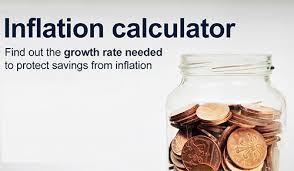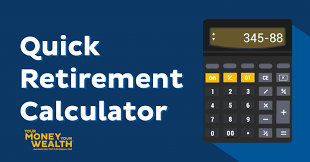Navigating the impact of inflation on your personal finances is easier with tool like the Inflation Calculator which is also called Inflation Value Calculator. This calculator provides valuable insights into purchasing power, future expenses, and investments, empowering you to make well-informed financial decisions and secure your financial future.Let us explore Price Inflation Calculator in the detail.
Inflation Calculator
Enter the initial price, the number of years, and the inflation rate:
The adjusted price is:
The inflation rate is:
What is Inflation?
Inflation is the rate at which the general level of prices for goods and services is increasing over a specific period. It is usually measured as a percentage increase in the Consumer Price Index (CPI), which is a basket of goods and services commonly purchased by households. The CPI includes items such as food, housing, healthcare, and transportation, among others.
Inflation occurs when the demand for goods and services exceeds the available supply, leading to an increase in prices. This can happen due to several factors, including an increase in the money supply, higher production costs, and an increase in demand.
Types of Inflation
There are different types of inflation, including:
Demand-Pull Inflation: This type of inflation occurs when demand for goods and services exceeds the supply. It leads to an increase in prices as consumers are willing to pay more for the limited supply.
Cost-Push Inflation: This type of inflation occurs when the production costs of goods and services increase. This can be due to an increase in the cost of raw materials, wages, or taxes, among others. As a result, producers raise their prices to maintain their profit margins, leading to an increase in the general price level.
Built-in Inflation: This type of inflation occurs when inflation expectations are built into the pricing of goods and services. For example, if workers expect prices to rise, they may demand higher wages, leading to an increase in production costs and prices.
Hyperinflation: This type of inflation is characterized by an extremely rapid increase in prices, usually over 50% per month. It occurs when there is a collapse of the monetary system, leading to a loss of confidence in the currency and an increase in demand for goods and services.
Impact of Inflation
Inflation has several impacts on the economy and everyday life, including:
Reduced Purchasing Power: Inflation reduces the purchasing power of money as prices increase. This means that the same amount of money can buy fewer goods and services, leading to a decline in the standard of living.
Increased Interest Rates: Inflation can lead to an increase in interest rates as lenders demand higher rates to compensate for the loss of purchasing power of money over time. This can discourage borrowing and investment, leading to a slowdown in economic growth.
Redistribution of Wealth: Inflation can redistribute wealth from creditors to debtors as the value of money decreases over time. Borrowers benefit from inflation as they pay back their loans with money that is worth less than when they borrowed it, while creditors lose.
International Competitiveness: Inflation can affect a country’s international competitiveness as it leads to higher prices for exports. This can make a country’s goods and services less attractive to foreign buyers, leading to a decline in exports and economic growth.
Inflation is a complex economic concept that affects everyone, from households to businesses and governments. Understanding the basics of inflation, its types, and its impacts can help individuals and policymakers make informed decisions and manage its effects on the economy and everyday life.
Hyperinflation?
Hyperinflation is a phenomenon that occurs when the rate of inflation exceeds 50% per month, leading to a rapid and extreme increase in prices. It can have devastating effects on the economy, including currency devaluation, social unrest, and economic collapse. In this article, we will explore the causes and effects of hyperinflation, as well as examples from history.
What Causes Hyperinflation?
Hyperinflation is typically caused by a combination of factors, including:
Money Supply: When a government or central bank prints more money than necessary, the excess supply can lead to an increase in prices as the demand for goods and services exceeds the available supply.
Economic Mismanagement: Poor economic policies, including excessive government spending, inefficient tax collection, and corruption, can lead to a loss of confidence in the currency and a decline in its value.
Political Instability: Political instability and uncertainty can cause investors and citizens to lose confidence in the currency, leading to a decline in demand and an increase in prices.
External Factors: Hyperinflation can also be caused by external factors such as war, natural disasters, or economic sanctions that disrupt the economy and lead to a decline in the value of the currency.
Effects of Hyperinflation
Hyperinflation can have severe consequences for the economy and society, including:
Currency Devaluation: Hyperinflation leads to a rapid decline in the value of the currency, making it virtually worthless. This can cause people to hoard goods, leading to shortages and further price increases.
Economic Collapse: It can cause to shut down, unemployment to rise, and the economy to collapse. This can lead to social unrest and political instability.
Loss of Savings: Hyperinflation can wipe out people’s savings as the value of the currency declines rapidly. This can lead to poverty and social unrest.
Redistribution of Wealth: Hyperinflation can redistribute wealth from savers to debtors as the value of debt decreases over time. This can lead to social unrest and political instability.
Examples of Hyperinflation
There have been several instances of hyperinflation throughout history, including:
Zimbabwe: In the early 2000s, Zimbabwe experienced hyperinflation due to a combination of economic mismanagement and political instability. At its peak, the inflation rate reached 79.6 billion percent per month, leading to the collapse of the economy and widespread poverty.
Germany: In the 1920s, Germany experienced hyperinflation due to the cost of World War I and the reparations imposed by the Treaty of Versailles. At its peak, the inflation rate reached 29,525% per month, leading to social unrest and political instability.
Hungary: In the aftermath of World War II, Hungary experienced hyperinflation due to the economic policies of the communist government. At its peak, the inflation rate reached 41.9 quadrillion percent per month, leading to the collapse of the economy and widespread poverty.
Hyperinflation is a rare but devastating economic phenomenon that can lead to currency devaluation, economic collapse, and social unrest. It is caused by a combination of factors, including excessive money supply, economic mismanagement, political instability, and external factors.
Why Inflation Occurs?
Inflation can be caused by both demand-side factors and supply-side factors.
Demand-Side Factors
Demand-side factors refer to changes in the level of aggregate demand in the economy. When aggregate demand exceeds the available supply of goods and services, prices tend to rise. This can be caused by:
Increased Consumer Spending: When consumers have more disposable income, they tend to spend more, leading to an increase in demand for goods and services.
Expansionary Monetary Policy: When central banks increase the money supply, it leads to an increase in demand for goods and services.
Government Spending: When the government increases spending, it can lead to an increase in demand for goods and services.
Supply-Side Factors
Supply-side factors refer to changes in the level of aggregate supply in the economy. When the available supply of goods and services is insufficient to meet demand, prices tend to rise. This can be caused by:
Decreased Productivity: When the production of goods and services decreases, it can lead to a decrease in the supply of goods and services.
Natural Disasters: Natural disasters can disrupt production and supply chains, leading to a decrease in the supply of goods and services.
Increased Production Costs: When the cost of production increases, it can lead to a decrease in the supply of goods and services.
How to calculate the inflation rate
Inflation can be calculated using different methods, including the Consumer Price Index (CPI) method, the Wholesale Price Index (WPI) method, and the GDP deflator method.
Consumer Price Index (CPI) Method
The CPI method is the most commonly used method for calculating inflation, as it measures the changes in the prices of a basket of goods and services commonly purchased by households. The steps to calculate inflation using the CPI method are as follows:
Step 1: Choose a base year and a current year. For example, let’s choose the base year as 2020 and the current year as 2021.
Step 2: Calculate the price of the basket of goods and services in the base year and the current year. This can be done by adding up the prices of each item in the basket and multiplying by the quantity purchased.
Step 3: Calculate the CPI for the base year and the current year by dividing the price of the basket in the current year by the price of the basket in the base year and multiplying by 100. The formula is: CPI = (Price of Basket in Current Year / Price of Basket in Base Year) x 100.
Step 4: Calculate the inflation rate by subtracting the CPI of the base year from the CPI of the current year, dividing by the CPI of the base year, and multiplying by 100. The formula is: Inflation Rate = ((CPI Current Year – CPI Base Year) / CPI Base Year) x 100.
Wholesale Price Index (WPI) Method
The WPI method measures the changes in the prices of goods traded in bulk by wholesale businesses. The steps to calculate inflation using the WPI method are as follows:
Step 1: Choose a base year and a current year. For example, let’s choose the base year as 2020 and the current year as 2021.
Step 2: Calculate the WPI for the base year and the current year by dividing the wholesale price index in the current year by the wholesale price index in the base year and multiplying by 100. The formula is: WPI = (Wholesale Price Index in Current Year / Wholesale Price Index in Base Year) x 100.
Step 3: Calculate the inflation rate by subtracting the WPI of the base year from the WPI of the current year, dividing by the WPI of the base year, and multiplying by 100. The formula is: Inflation Rate = ((WPI Current Year – WPI Base Year) / WPI Base Year) x 100.
GDP Deflator Method
The GDP deflator method measures the changes in the prices of all goods and services produced in an economy. The steps to calculate inflation using the GDP deflator method are as follows:
Step 1: Choose a base year and a current year. For example, let’s choose the base year as 2020 and the current year as 2021.
Step 2: Calculate the GDP deflator for the base year and the current year by dividing the nominal GDP in the current year by the real GD.
Problems with Measuring Inflation
Measuring inflation is an important task for governments, central banks, and economists, as it provides valuable insights into the health of the economy and the purchasing power of consumers. However, the process of measuring inflation is not without its challenges. In this article, we will explore some of the problems with measuring inflation and why they matter.
Problem #1: Quality Adjustments
One of the challenges of measuring inflation is accounting for changes in the quality of goods and services over time. For example, a laptop purchased in 2021 may have more advanced features and better performance than a laptop purchased in 2010, but its price may not have increased proportionally. To address this issue, statisticians use quality adjustments to account for changes in quality when calculating inflation.
However, quality adjustments can be subjective and may not accurately reflect the value of the changes in quality. This can lead to an understatement or overstatement of inflation, depending on the type of adjustment used.
Problem #2: Substitution Bias
Another problem with measuring inflation is substitution bias, which occurs when consumers substitute one good for another in response to changes in relative prices. For example, if the price of beef increases, consumers may switch to buying chicken instead. However, if the inflation measure does not account for this substitution, it may overestimate the inflation rate for beef and underestimate it for chicken.
To address this issue, economists use a technique called the chained Consumer Price Index (CPI), which adjusts for substitution bias by taking into account the changing basket of goods and services that consumers purchase over time.
Problem #3: Regional Differences
Measuring inflation can also be challenging due to regional differences in prices. For example, the cost of living in New York City is much higher than in a small town in rural America. Therefore, the inflation rate experienced by consumers in different regions may vary significantly.
To address this issue, statisticians use regional price indexes to calculate inflation rates for specific regions. However, the accuracy of these regional price indexes depends on the availability of price data, which may be limited in some regions.
Problem #4: New Products and Services
The introduction of new products and services can also present challenges for measuring inflation. For example, the rise of e-commerce and digital services has led to the creation of new products and services that did not exist a few years ago. These products and services may not have a historical price record, making it difficult to include them in inflation calculations.
To address this issue, statisticians use various techniques to estimate the prices of new products and services, such as hedonic pricing, which uses the characteristics of a product or service to estimate its value.
Problem #5: Time Lags
Finally, measuring inflation can be challenging due to time lags. It takes time for price changes to be reflected in the data used to calculate inflation, which can lead to inaccuracies in the inflation rate. Moreover, the time lag can vary depending on the frequency of data collection, which can lead to differences in inflation rates calculated using different data sets.
To address this issue, statisticians use various techniques to estimate inflation in real-time, such as nowcasting, which uses a combination of past data and high-frequency data to estimate inflation rates in real-time.
Measuring inflation is a critical task for understanding the health of the economy and the purchasing power of consumers. However, the process of measuring inflation is not without its challenges. Quality adjustments, substitution bias, regional differences, new products and services, and time lags can all affect the accuracy of inflation measures.
Inflation and how it affect to investors
How Does Inflation Affect Investors?
Inflation can have a significant impact on investors in several ways. The most significant impact of inflation is that it erodes the purchasing power of money. As the value of money decreases, investors need to pay more to buy the same goods and services they could buy for less before inflation. This means that investors need to earn a higher return on their investments just to keep up with inflation.
Inflation can also impact the stock market. When inflation is high, companies may have to pay more for their inputs, such as raw materials, which can reduce their profit margins. This can lead to a decrease in stock prices, as investors become less willing to pay the same price for a stock that generates lower profits.
Inflation can also impact the bond market. When inflation is high, interest rates tend to rise, as investors demand higher returns to compensate for the decrease in the value of money. This can lead to a decrease in the price of existing bonds, as their yields become less attractive compared to newly issued bonds that offer higher yields.
How Can Investors Mitigate the Impact of Inflation?
While inflation can have a significant impact on investors, there are ways to mitigate its impact on investment portfolios. One way is to invest in assets that have a history of performing well during periods of high inflation. These assets may include commodities such as gold, which tends to increase in value during periods of inflation, or real estate, which can benefit from rising rental rates.
Another way to mitigate the impact of inflation is to invest in stocks of companies that have pricing power. These companies have the ability to increase their prices to compensate for the increase in the cost of their inputs, which can help them maintain their profit margins during periods of inflation.
Investors can also mitigate the impact of inflation by investing in inflation-protected securities, such as Treasury Inflation-Protected Securities (TIPS). These securities are designed to provide investors with a return that is adjusted for inflation, which can help to preserve the purchasing power of their investments.
Inflation is an important economic indicator that can have a significant impact on investors. It can erode the purchasing power of money, impact the stock and bond markets, and reduce the value of investment portfolios. However, investors can mitigate the impact of inflation on their portfolios by investing in assets that perform well during periods of inflation.
How to Beat Inflation?
We’ll explore some of the best strategies for beating inflation and keeping your finances on track.
- Invest in stocks
One of the best ways to beat inflation is to invest in the stock market. Historically, stocks have outperformed inflation over the long term, making them a great choice for investors who want to grow their wealth. However, keep in mind that the stock market can be volatile, and there are no guarantees that you’ll make money.
- Buy real estate
Real estate can be another great hedge against inflation. When inflation goes up, so do the prices of houses, apartments, and other properties. If you own real estate, its value will increase with inflation, protecting your investment from losing value over time. However, keep in mind that real estate investments come with their own risks, including the possibility of a housing market crash.
- Invest in commodities
Another way to beat inflation is to invest in commodities, such as gold, silver, and oil. These assets have historically been a good hedge against inflation, as their prices tend to rise when inflation is high. However, investing in commodities can be risky, as their prices can be volatile and subject to geopolitical events.
- Save aggressively
Saving aggressively is another effective way to beat inflation. By saving as much as you can, you can build up a large emergency fund or retirement account that can help you weather inflation and other financial challenges. Consider automating your savings by setting up automatic contributions to your savings account or retirement plan.
- Cut back on spending
Finally, one of the simplest ways to beat inflation is to cut back on your spending. By reducing your expenses, you can free up more money to save or invest, which can help you keep up with inflation. Consider making a budget and finding ways to cut back on non-essential expenses, such as eating out or buying expensive clothing.
In conclusion, inflation can be a challenging obstacle for anyone trying to build and protect their wealth. However, by investing in stocks, buying real estate, investing in commodities, saving aggressively, and cutting back on spending, you can beat inflation and keep your finances on track.
Inflation can have a significant impact on our financial lives, both in the short term and over the long term. However, it can be difficult to accurately gauge the true impact of inflation over time. That’s where historical and real inflation rate calculators come in – these powerful tools can help you better understand how inflation has affected your purchasing power and investment returns over the years. In this article, we’ll explore the benefits of using these calculators, as well as provide a review of an inflation impact calculator that can help you more accurately estimate the impact of inflation on your financial goals.
The Inflation Calculator
Inflation is an economic reality that impacts our lives in numerous ways. It erodes the purchasing power of our money over time, making it essential to understand its effects and how it can affect our financial planning. The Inflation Calculator, often referred to as a Price Inflation Calculator or Inflation Value Calculator, is a valuable tool that helps individuals comprehend the impact of inflation on their finances. In this article, we’ll explore the significance of the Inflation Calculator and how it can be used to make informed financial decisions.
Unveiling the Dynamics of Inflation:
Inflation is the rise in the general price level of goods and services over time. This means that over the years, the same amount of money can buy less. Understanding inflation is crucial for various reasons, as it can influence your savings, investments, and overall financial strategy.
The Role of an Inflation Calculator:
An Inflation Calculator is designed to quantify the effects of inflation on purchasing power. By inputting key information, you can estimate the future value of money, goods, or services, considering the expected inflation rate. Here’s how it can be beneficial:
1. Projecting Future Costs: An Inflation Calculator enables you to project the future cost of items or services based on historical or expected inflation rates. This can be particularly useful for planning for major expenses like education, healthcare, or retirement.
2. Investment Planning: For investors, understanding the effects of inflation is essential. An Inflation Calculator helps assess how investment returns may be impacted by inflation and aids in developing strategies to outpace it.
3. Retirement Planning: When planning for retirement, it’s essential to consider the effects of inflation on your expenses. The calculator can provide insights into the income you’ll need in the future to maintain your current lifestyle.
4. Cost of Living Adjustments: An Inflation Calculator is also valuable for assessing the impact of cost-of-living adjustments on pensions, Social Security benefits, and wage increases.
Using an Inflation Calculator:
To employ an Inflation Calculator, you’ll need to follow these steps:
Input the Initial Value: Start by entering the initial value of the item or service you want to evaluate.
Specify the Time Period: Determine the number of years over which you want to calculate the impact of inflation.
Enter the Inflation Rate: Provide the expected or historical inflation rate.
Review the Results: The calculator will then provide you with the projected future value of the item or service based on the inflation rate.
Conclusion:
Inflation is an economic phenomenon that affects everyone. To navigate the financial landscape effectively, it’s vital to comprehend its implications and plan for the future accordingly. The Inflation Calculator, whether known as a Price Inflation Calculator or Inflation Value Calculator, empowers individuals to make more informed financial decisions by understanding the impact of inflation on their savings, investments, and overall financial health. By incorporating this tool into your financial planning, you can develop strategies that help you maintain and even grow your purchasing power in the face of inflation’s relentless march.

FAQ on Inflation
1. What is inflation?
- Inflation is the economic phenomenon characterized by the general increase in the prices of goods and services over time. It leads to a decrease in the purchasing power of a currency.
2. How does inflation affect my finances?
- Inflation erodes the value of your money over time. As prices rise, the same amount of money can buy fewer goods and services. This impacts your savings, investments, and overall cost of living.
3. What is the significance of an Inflation Calculator?
- An Inflation Calculator, also known as a Price Inflation Calculator or Inflation Value Calculator, helps individuals assess the impact of inflation on future expenses, investments, and purchasing power.
4. How can I use an Inflation Calculator?
- To use an Inflation Calculator, input the initial value of the item or service, specify the time period, and enter the expected or historical inflation rate. The calculator will then provide you with the projected future value based on the inflation rate.
5. Why is it important to consider inflation in investment planning?
- Considering inflation is crucial in investment planning because it helps you understand how inflation can erode the real return on your investments. By accounting for inflation, you can develop strategies to ensure your investments outpace it.
6. How does inflation impact retirement planning?
- Inflation affects retirement planning by increasing the cost of living over time. To maintain your desired lifestyle in retirement, you need to account for the impact of inflation on your expenses and income. This is where an Inflation Calculator can be useful.
7. Can inflation be beneficial in some cases?
- While inflation is generally seen as a negative force, moderate inflation can be beneficial for stimulating economic growth. However, high or hyperinflation can have detrimental effects on an economy.
8. What strategies can I use to protect my finances from the effects of inflation?
- To protect your finances from inflation, consider investments that typically outperform inflation, such as stocks, real estate, and commodities. Diversifying your portfolio can also help.
9. How often should I review my financial plans in light of inflation?
- It’s a good practice to review your financial plans regularly, especially when considering long-term goals like retirement or major expenses. Annual reviews are often recommended to ensure that your plans remain aligned with your financial objectives.
10. What are some historical examples of significant inflation?
Historical examples of significant inflation include the hyperinflation in Germany during the Weimar Republic in the 1920s and more recent examples like Zimbabwe’s hyperinflation in the late 2000s.
11. How does an Inflation Value Calculator help in cost-of-living adjustments and wage increases?
An Inflation Value Calculator can help assess the impact of inflation on cost-of-living adjustments, pensions, Social Security benefits, and wage increases. It allows individuals and organizations to make informed decisions regarding adjustments to keep up with rising prices.
Inflation Calculator – Inflation Value Calculator – Price Inflation Calculator
Legal Notices and Disclaimer
All Information contained in and produced by the ModernCalculators.com is provided for educational purposes only. This information should not be used for any Financial planning etc. Take the help from Financial experts for any Finace related Topics. This Website will not be responsible for any Financial loss etc.





